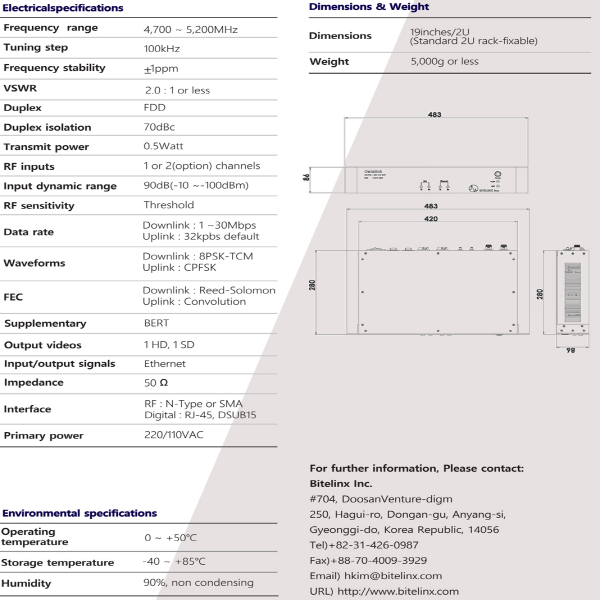UHF-band Datalink Transceiver
The BDL-UB
is a UHF-band full-digital transceiver for datalink. The uplink and downlink data traffic shares the aerial link based on TDD/TDMA that supports up to 10 nodes. the TDD/TDMA slots are designed to cover a mission range of 100km. the Master/Slave mode enables the slave node or nodes to operate in synchronization with the master node without access to the GPS service. The CPFSK waveform, compliant with IRIG-106, is immune to such impairments as frequency drift and non-linear distortion and is further protected by an FEC, Reed-Solomon. Users can easily configure a BDL-UB module as either a ground or onboard unit using software.
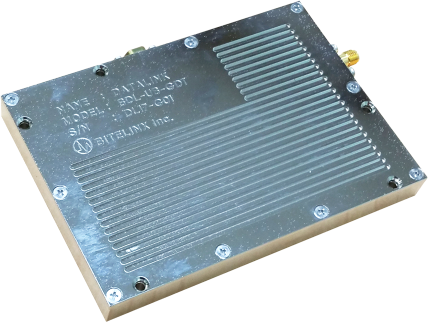
- 1W full digital UHF-band transceiver
- 410~480MHz, 100kHz step
- GPS-aided or Master/Slave TDD/TDMA
- Up to 10 nodes supported by TDMA
- Data rate up to 160kbps
- 200/100kHz bandwidth CPFSK for both downlink and uplink
- Reed-solomon and BERT
- Compact, light module
RF features
Users have a 70MHz programmable tuning range within 410MHz and 480 MHz in steps of 100kHz and alternately Access the wireless medium for communication between two nodes or among more, based on TDD and TDMA, respectively. Considering the round-trip propagation delay for a mission range of 100km, the BDL-UB secures a guard interval of about 0.7ms between transmissions of data. A data rate up to 160bps is supported in the wide band mode while halved down in the narrowband mode where the bandwidth is 100kHz.
Waveforms
The CPFSK is a very reliable waveform, the performance of which has been used reliably for decades. The Reed-Solomon code dramatically improves the link performance. The full-digital feature allows the user to select another waveform from among MSK, GMSK and GFSK, depending on the application. The frame is designed to support TDD/TDMA accommodating 200 time slots of 5ms per second. this minimizes the transmission delay required for round-trip propagation and signal processing. Users can also choose the band operation mode either wideband or narrowband, subject to frequency or bandwidth requirements. Up to 10 nodes can alternately the aerial link on the basis of a compact PHY and TDMA MAC protocol.
Supplementary functions
Users can test a link performance by simply changing the transmit mode into BERT available for both downlink and uplink.
Dedicated software
The GUI software allows users not only to easily configure the transceiver according to the operational purpose but to also monitor the performance.
Equipment component
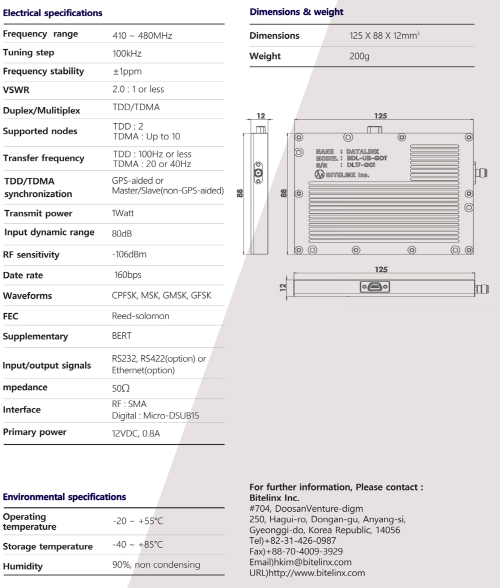
C-band Onboard Datalink Transceiver
The BDL-CB ADT
is a C-band full-digital onboard transceiver for datalink. The uplink and downlink data traffic share the aerial link based on FDD. It transmits two channel video and one FCC data over a downlink while receiving control and mission data over an uplink. The high-performance downlink waveform, 8PSK-TCM, allows for a bandwidth-efficient, reliable transmission of data. The datalink system is designed so as to cover up a mission range of up to 50km.
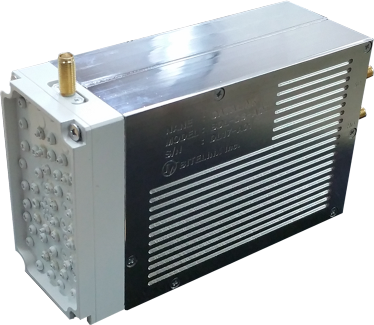
- Full digital C-band FDD transceiver
- +27dBm transmit power
- 2 video ports(1HD & 1SD)
- 7Mbps downlink (extendable up to 30Mbps)
- 4.8MHz bandwidth for downlink
- 8PSK-TCM downlink, CPFSK uplink
- Concatenated FEC coding with Reed-Solomon
- BERT for both downlink and uplink
RF features
The downlink and uplink frequencies are tuned to 5,145MHz and 5,035MHz, respectively. Users need to choose from two different sets of two frequencies between 4.7 ~ 5.2GHz at the time of ordering, because the FDD diplexer has to be so properly tuned as to support the frequencies. The diplexer secures an isolation of 70dBc between downlink and uplink. The frequency stability of the LO used is less than ±1ppm and its phase noise is also very low, for those LO characteristics are critical to the downlink over which the PSK-TCM modulated signal is transmitted. With a mission range of 50km, the transmit power over the downlink is 1W and can be digitally adjusted down if necessary.
Waveforms
The highly bandwidth-efficient 8PSK-TCM allows for a reliable transmission of bulk data over a downlink through a narrow bandwidth. Concatenated with Reed-Solomon, the convolution code nature of the modulated signal helps dramatically improve the link performance. The CPFSK for uplink is also a very robust waveform, the performance of which has been used reliably for decades in the Telemetry industry. The BDL-CB-ADT, compliant with the IRIG-106 standard, is immune to such impairments as frequency drift, non-linear distortion, amplitude fluctuation and so on. The narrow-bandwidth uplink traffic is further protected by the Convolution Code.
Supplementary functions
Users can test link performance by simply changing the transmit mode into BERT which is available for both downlink and uplink.
Dedicated software
The GUI software allows users not only to easilyh configure the transceiver according to the operational purpose but also to monitor the performance.
Equipment component

C-band Ground Datalink Transceiver
The BDL-CB-GDT
is a C-band full-digital ground transceiver for datalink and supports up to 2 RF inputs. The uplink and downlink data traffic shares the aerial link based on FDD. It receives two channel video and one FCC data through downlink while transmitting control and mission data via uplink. The high-pwerformance downlink waveform, 8PSK-TCM, allows for a bandwidth-efficient, reliable transmission of data. The datalink system is designed so as to cover up a mission range of 50km.
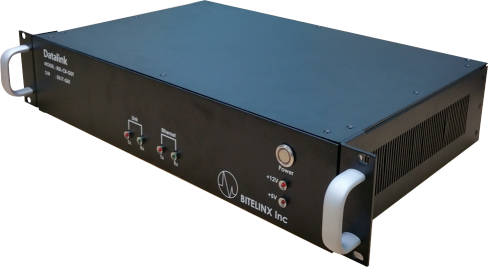
- C-band full digital FDD transceiver
- +27dbm transmit power
- 7Mbps downlink(extendable up to 30Mbps)
- 4.8MHz bandwidth for downlink
- 8PSK-TCM downlink, CPFSK uplink
- Concatenated FEC coding with Reed-Solomon
- BERT for both downlink and uplink
- Standard 2U rack-fixable
RF features
The downlink and uplink frequencies are tuned to 5,145MHz and 5,035MHz, respectively. Users can choose from two different sets of frequencies between 4.7 ~ 5.2GHz at the time of ordering, because the FDD diplexer needs to be properly tuned. The diplexer secures an isolation of 70dBc between the downlink and the uplink. The frequency stability of the LO used is less than ±1ppm and its phase noise is also very low, for those LO characteristics are critical to the downlink over which the PSK-TCM modulated signal is transmitted. With a mission range of 50km, the transmit power over downlink is 1W and can be digitally adjusted down if necessary.
Waveforms
The highly bandwidth-efficient 8PSK-TCM allows for a reliable transmission of bulk data over a downlink through a narrow bandwidth. Concatenated with Reed-Solomon, the convolution code nature of the modulated signal helps dramatically improve the link performance. The frame is designed to be suitable for transmission of TS video packets, minimizing the processing delays. The CPFSK used for uplink is also a very reliable waveform, the performance of which has been used reliably for decades in the Telemetry industry. The BDL-CB-GDT, compliant with the IRIG-106 standard, is immune to such impairments as frequency drift, non-linear distortion, amplitude fluctuation and so on. The narrow-bandwidth uplink traffic is further protected by the Convolution Code.
Supplementary functions
Users can test a link performance by simply changing the transmit mode into BERT which is available for both downlink and uplink.
Dedicated software
The GUI software allows users to not only easily configure the transceiver according to the operational purpose but also to monitor the performance.
Equipment component
